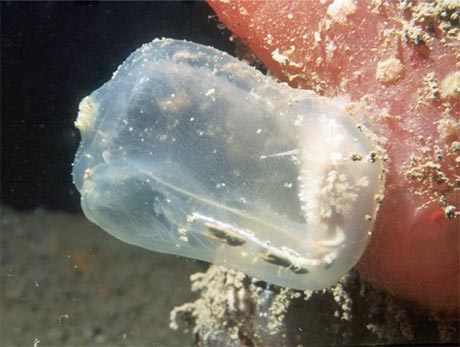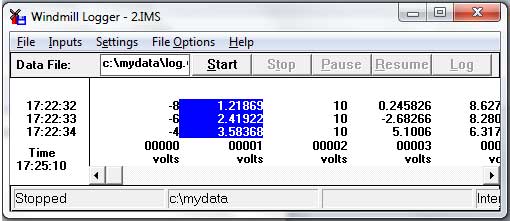Monitor - ISSN 1472-0221
The Newsletter for PC-Based Data Acquisition and Control
Issue 203, June 2015
Welcome to Monitor, the data acquisition and control newsletter. Read on for a story of how Windmill software is helping research scientists investigate mussel farmers' problems with sea squirts. We also answer questions on using Windmill with Excel.
I hope you find the newsletter useful, but should you wish to remove yourself from our mailing list, go to windmillsoft.com/daqshop/Monitor_Newsletter.html
You can download Monitor as a pdf file from https://www.windmill.co.uk/monitor/monitor203.pdf.
Contents
* Windmill Software aids Aquaculture Research in the Lab
* Windmill Questions
* Excel Corner
* DAQ News Round-up
Windmill Software aids Aquaculture Research in the Lab
Web Link: https://www.windmill.co.uk/fluorescence-monitoring.html
Mussel farmers in Canada are having problems with sea squirts. A sea squirt (more properly called a tunicate) is a marine animal that looks like a little soft vase. In the wrong place they can cause massive economic damage with around 63% of the mussel harvest lost.

Tunicate or Sea Squirt
Scientists at Fisheries and Oceans Canada researching the problem are using Windmill Software to help with their investigations.
A tunicate sticks itself to a hard surface, which are scarce in the mussel farming areas. Longline mussel farming gear and the mussels themselves, though, provide perfect attachment points for these invasive species. This causes the mussel farmers two headaches: during harvesting additional labour is needed to remove the tunicates from the mussels and, more importantly, they cause considerable crop loss.
The farmers grow the mussels on many 2 m long polyethylene sleeves or socks attached to long lines. Over 4000 tunicates can infest just one of these sleeves. The weight of the tunicates breaks the mussels hold on the lines and they fall to the bottom where they can't be harvested. Another problem faced by the mussels is the competition for food from the tunicates.
Mussels obtain all of their nutritional requirements naturally from the sea without additional feeding by farmers. Both the mussels and the tunicates eat phytoplankton (microscopic plant-like organisms). The scientists - Luc A. Comeau, Ramon Filgueira, Thomas Guyondet and Remi Sonier - are looking into how the presence of tunicates affected the food available to the mussels.
In the laboratory the researchers set up tanks of mussels and tunicates. To determine how much phytoplankton was in the water they measured the fluorescence of chlorophyll. To do this they connected a fluorometer (CYCLOPS-7 submersible sensor from Turner Designs) to a Microlink 751 data acquisition controller and used Windmill Software to collect the data. Windmill logged readings and provided a near real-time (5 second delay) graphical display of fluorescence. After an hour the researchers stopped the flow of water and monitored the exponential decline in fluorescence over time on the computer screen.
The scientists found that at non-infested sites the demand for phytoplankton was less than the ecosystems renewal capacity. Where tunicates colonise mussel sleeves though, phytoplankton demand could outpace supply. The tunicates take more of the pico-phytoplankton (the smallest phytoplankton) than the mussels and quickly grow and multiply.
Windmill software's low-cost data acquisition system helped the researchers conclude that when mussel sleeves are fouled with tunicates there is a significant alteration in the demand for food particles. The multi-function nature of the system means that the Microlink hardware and Windmill software can be used in many future research projects - interfacing all sorts of different instruments and sensors to a computer.
Further Reading:
Microlink 751 with Windmill Software
Was £595 now just £295
https://www.windmillsoft.com/
Comeau, Luc A., et al. "The impact of invasive tunicates on the demand for phytoplankton in longline mussel farms." Aquaculture 441 (2015): 95-105.
http://www.sciencedirect.com/
Fisheries and Oceans Canada
http://www.dfo-mpo.gc.ca/
Turner Designs
http://www.turnerdesigns.com/
Questions on Using Windmill
Question
I want to ask you a couple of questions. First I need to know How can I transform the xxx.wl file to excel?. The second one is, where can I find the file?.
Answer
Windmill Logger saves readings in a *.wl file. You can import this file into Excel for analysis.
In Excel, from the File menu select Open and select the *.wl file. The Text Import Wizard appears. Choose Delimited then click Finish.

The logged data file (*.wl) is now in Excel ready for saving in Excel format.
By default you will find the *.wl file in the data directory under wherever you installed Windmill, for example c:\windmill\data\. If you want to save it somewhere else just enter the full path in Logger's Data File box.

You are also able to use Windmill to collect data directly in Excel.
Any questions on using Windmill you'd like to see answered here, just ask: monitor@windmillsoft.com. Subscribers can download a trial copy of Windmill. This will collect data from any instrument which can communicate with a computer over RS-232, RS-485, Modbus, Ethernet, Internet or TCP-IP.
Excel Corner
Web Link: https://www.windmill.co.uk/excel/excel-if-then-else.htmlWhen writing a macro in Excel you can incorporate an "if then else" statement: IF (something is true) THEN (do something) ELSE (do something else)
You can't do this in a simple cell formula, but there is a way round it. You can use several IF functions together: nested IFs.
A basic IF function takes the format
IF(logical_test,value_if_true,value_if_false)
for example, if you had a temperature reading in cell B2 you might use
=IF(B2>35,"TOO HOT","ok")
Excel displays "TOO HOT" if the reading is over 35 degrees and "ok" if it is 35 degrees or under.
You could also add a warning option to show when the temperature was getting too warm, for example.
=IF(B2>35,"TOO HOT",IF(B2>30,"warning - hot",IF(B2<=30,"ok")))
Here we have put another IF statement into the value_if_false position. So if the temperature is over 35 degrees Excel goes no further and writes "TOO HOT". If not it goes onto the next statement. If this is not true it carries on until it finds a statement that is.
You can continue in this way with up to 7 IF statements. So in our example you could add "too cold" warnings as well.
=IF(B2>35,"TOO HOT",IF(B2>30,"warning - hot",IF(B2>5,"ok",IF(B2>0,"warning - cool",IF(B2<=0,"TOO COLD")))))

Further Reading
For more Excel tips see https://www.windmill.co.uk/excel/excel-tips.html. If you have a question on using Excel please contact monitor@windmillsoft.com
DAQ News Round-up
Welcome to our round-up of the data acquisition and control news. If you would like to receive more timely DAQ news updates then follow us on Twitter - @DataAcquisition or grab our rss feed.
Semiconductor crystals could be key to extending Moore's Law
IBM researchers have developed a process for growing crystals made from semiconductor materials, which they claim can then be integrated onto silicon chips in a crucial step forward for the future of computing.
Source: The Engineer
https://www.theengineer.co.uk/
It's a Trap! But That's Okay for Novel Light-Detecting Material
Charge-trapping defects that are typically problematic in solar cells can be an asset when engineering sensitive light detectors.
Source: NIST
https://www.nist.gov/
Capturing wasted cell phone energy and using it to charge battery
New technology makes cell phone batteries last up to 30 percent longer on a single charge.The patented circuitry converts some of the radio signals emanating from a phone into direct current (DC) power, which then charges the phone's battery.
Source: Ohio State University
https://news.osu.edu/
The internet is running out of room - but we can save it
With more of us online, thirsty for media and information, we're nearing the maximum capacity of optical fibres, meaning the internet must adapt to survive
Source: New Scientist
http://www.newscientist.com/
* Copyright Windmill Software Ltd
* Reprinting permitted with this notice included
* For more articles see https://www.windmill.co.uk/
We are happy for you to copy and distribute this
newsletter, and use extracts from it on your own web
site or other publication, providing the above notice
is included and a link back to our website is in place.
For previous issues by subject see https://www.windmill.co.uk/monitorindex.html
DOWNLOAD DATA ACQUISITION SOFTWARE
As a thank you for subscribing we offer you the ComDebug data logging and Com port trouble-shooting software. Log data over RS232, RS422, RS485 or Modbus. Also included is a month's trial of the Windmill 7 logging, charting and control programs.
SUBSCRIBING OR CANCELLING SUBSCRIPTION Visit https://www.windmill.co.uk/newsletter.html and add or remove your e-mail address.
Windmill Software Ltd, PO Box 58, North District Office,
Manchester, M8 8QR, UK
Telephone: +44 (0)161 834 6688
Facsimile: +44 (0)161 833 2190
E-mail: monitor@windmillsoft.com
https://www.windmill.co.uk/
https://www.windmillsoft.com/
